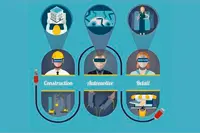 A report from Beecham Research suggests that, while most of the hype around augmented reality (AR) has tended to focus on consumer technology, growth in demand over the next five years will come from business applications.
A report from Beecham Research suggests that, while most of the hype around augmented reality (AR) has tended to focus on consumer technology, growth in demand over the next five years will come from business applications.
According to the report – Augmented Reality and Wearable Technology – manufacturing, logistics, healthcare and retail are likely to be among the most active markets, with AR offering a new way for people to interact with information hands-free, to provide a greater depth of control and access to knowledge.
The report highlights a number of recent acquisitions that reflect a growing level of market activity and consolidation, including PTC’s purchase of Vuforia for $65million to support its next generation of technology solutions for manufacturers. This follows acquisitions of IoT companies ThingWorx and Axeda.
Recently, the Financial Times reported that Apple had set about assembling a team of experts specialising in VR and AR and would be looking to build prototypes of headsets to rival the Oculus Rift or the Microsoft’s Hololens.
“It is clear the overall status of the enterprise market for AR and wearable technology is at a tipping point, moving from trials and testbed projects to real commercial deployments,” said Matthew Duke-Woolley, Beecham Research analyst and author of the report.
Valerie Riffaud-Cangelosi, Epson’s new markets development manager, agrees and believes the market is set for strong growth. “We unveiled our first AR product – the Moverio BT-100 – five years ago. Today, our BT-200 smart glasses offer both video and access to new AR experiences for a variety of commercial and vertical market applications.
“What is a significant change is that we are now seeing new products being brought to market that are very affordable.”
The report looks at some of the emerging business applications of AR and wearable technology, such as: head up displays in manufacturing systems to support complex production processes; collaborative product design and prototyping; remote assistance of specialist distant engineers and technicians; medical systems to enable surgeons to access relevant data in theatre without being distracted; and education and training.
At the year’s CES in Las Vegas, Intel launched Smart Helmet, said to be capable of delivering ‘x-ray like vision’.
Co-developed with the augmented reality company Daqri and using Intel’s latest processor and camera technology, Smart Helmet has been designed primarily for the industrial market. It will allow the wearer to effectively peer into the workings of objects using real-time overlay of information – such as wiring diagrams and schematics – and see problem areas that need fixing.
“Current human-computer interfaces in mobile computing are primarily based around touchscreens, but AR – along with wearable technology – enables greater interaction with information and the user’s surroundings,” said Saverio Romeo, principal analyst at Beecham Research. “We expect to see rapid evolution of smart glasses, with more miniaturisation, better field of view and battery life, while there will also be increasing attention on the convergence with VR technology and the IoT to deliver a greater competitive advantage. Collaboration with AR/VR and IoT players will be crucial.”
According to Duke-Woolley: “While it is still questionable to provide a firm forecast, if this speed of transition accelerates as companies quickly recognise the benefits and return on investment, we believe the market could quite possibly reach $800m by 2020.”
Author
Neil Tyler
Source: www.newelectronics.co.uk

